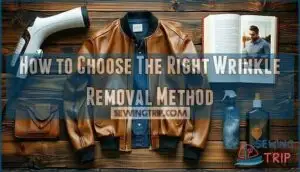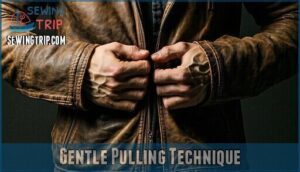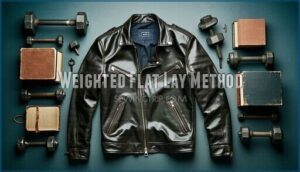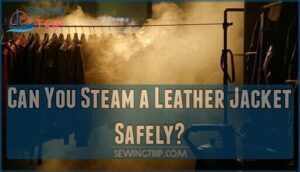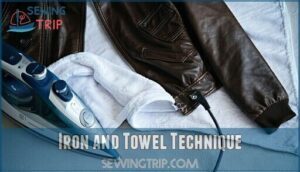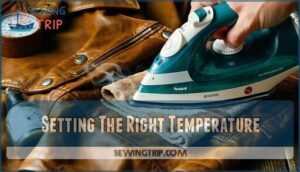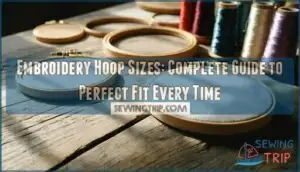This site is supported by our readers. We may earn a commission, at no cost to you, if you purchase through links.
 You can tackle those stubborn wrinkles in your leather jacket with six safe methods. Start by gently pulling wrinkled areas and laying the jacket flat under books for light creases. For deeper wrinkles, use a handheld steamer held 6 inches away, or hang your jacket in a steamy bathroom. The iron method works too—place a cotton towel over the wrinkle and use low heat.
You can tackle those stubborn wrinkles in your leather jacket with six safe methods. Start by gently pulling wrinkled areas and laying the jacket flat under books for light creases. For deeper wrinkles, use a handheld steamer held 6 inches away, or hang your jacket in a steamy bathroom. The iron method works too—place a cotton towel over the wrinkle and use low heat.
Always test on a hidden spot first, since leather can go from smooth to ruined quickly. Quality full-grain leather responds differently than cheaper blends, so matching your technique to the material prevents costly mistakes.
The real key to success lies in understanding why your jacket wrinkles in the first place.
Table Of Contents
- Key Takeaways
- Why Do Leather Jackets Get Wrinkles?
- How to Choose The Right Wrinkle Removal Method
- Pulling and Laying Flat: Quick Fixes for Light Wrinkles
- Can You Steam a Leather Jacket Safely?
- Can You Iron a Leather Jacket Without Damage?
- Preventing Wrinkles in Leather Jackets
- Frequently Asked Questions (FAQs)
- Conclusion
Key Takeaways
- Test any method on a hidden area first to avoid damaging your jacket’s finish or color – different leather types react differently to heat and moisture.
- Match your wrinkle removal technique to your leather’s quality – full-grain leather handles steaming well, while cheaper blends need gentler approaches like weighted flattening.
- Use protective barriers when applying heat – place a cotton towel between your iron and leather, or keep steamers 6+ inches away to prevent scorching or cracking.
- Prevent future wrinkles by storing your jacket on wide wooden hangers and conditioning it every 3-6 months to maintain flexibility.
Why Do Leather Jackets Get Wrinkles?
Your leather jacket develops wrinkles from everyday wear, improper storage, and the natural aging process of the material. Poor-quality leather and dry, unconditioned pieces are more prone to creasing.
Cramped closet conditions and flimsy hangers can accelerate wrinkling, while well-conditioned leather retains its flexibility and resists wrinkles better.
Common Causes of Leather Wrinkles
Your leather jacket develops wrinkles from several culprits. Fold creases form when you hang it improperly or stuff it in tight spaces. Pressure marks appear from sitting or leaning against surfaces.
Humidity effects cause the leather to expand and contract, creating material fatigue over time. Leather aging naturally makes fibers less resilient.
Regular use of leather conditioner helps prevent wrinkles by maintaining flexibility.
How Leather Quality Affects Wrinkling
Not all leather jackets wrinkle the same way. Your jacket’s leather grade directly impacts how quickly creases form and how stubborn they become.
Here’s how leather quality affects wrinkling:
- Hide Thickness – Thicker leather from the animal’s midsection resists wrinkles better than thin belly leather
- Leather Grade – Full-grain develops natural wrinkles easily but stays strong, while top-grain hides imperfections through the tanning process
- Material Blends – Genuine and bonded leathers crease quickly due to weaker fiber structure
- Finishing Techniques – Chemical treatments and surface coatings reduce wrinkle formation substantially
- Leather Types – Premium options like shell cordovan resist creasing due to tight fiber structures
Quality leather conditioning helps maintain flexibility regardless of grade. Understanding the differences in leather quality types is essential for choosing the right leather care products.
Storage and Handling Mistakes
Your storage habits matter more than you think. Improper folding creates permanent creases that resist removal. Cheap hangers leave shoulder marks and cause fabric stress. Inadequate storage in cramped spaces forces unnatural shapes.
Without delicate handling and proper moisture control, your jacket suffers.
Store properly in cool, dry areas using wide hangers to prevent future wrinkles.
How to Choose The Right Wrinkle Removal Method
You’ll need to match your wrinkle removal method to your leather’s type and condition since different leathers respond differently to heat, moisture, and pressure.
Start by checking if your jacket has delicate finishes, deep creases, or signs of aging that might require professional care instead of DIY methods.
Assessing Leather Type and Condition
Before tackling wrinkles, you need to identify your leather’s personality. Full-grain leather shows natural grain patterns and responds well to conditioning, while top-grain leather has a uniform texture.
Check your leather jacket’s thickness and finish—thicker hides resist damage better. Examine the material quality and condition assessment reveals dry, cracked areas needing gentle treatment.
Proper leather conditioning starts here. Understanding the leather care tips is essential for maintaining your jacket’s quality.
When to Use Home Vs. Professional Methods
Once you’ve assessed your leather’s condition, deciding between home remedies and professional leather repair becomes straightforward. Light wrinkles respond well to DIY wrinkle removal methods, while deep creases need expert attention.
Here’s when to choose each approach:
- Home methods work for surface-level wrinkles on quality leather in good condition
- Professional help needed for vintage, cracked, or severely damaged jackets requiring specialized leather conditioning
- DIY iron leather jacket techniques suit minor fold lines you can handle safely
- Expert leather care required when previous home attempts failed or worsened the problem
- Professional leather repair essential for expensive designer pieces worth preserving properly
Pulling and Laying Flat: Quick Fixes for Light Wrinkles
When you notice light creases across your leather jacket’s surface, you don’t need heavy-duty methods to smooth them out.
Start with simple hand stretching and flat laying techniques that work with leather’s natural flexibility to restore its original shape.
Gentle Pulling Technique
Start with the simplest approach for light creases. Gently grasp both sides of the wrinkled area and pull outward with steady pressure. This leather stretching technique works through fabric relaxation, allowing natural wrinkle release without tools.
| Technique | Best For | Time Required |
|---|---|---|
| Gentle Tugging | Surface wrinkles | 30 seconds |
| Cross-pull method | Corner creases | 1 minute |
| Progressive stretching | Deep fold lines | 2-3 minutes |
| Area massage | Stubborn spots | 5 minutes |
Follow with leather conditioner application for ideal crease removal results.
Weighted Flat Lay Method
This overnight leather relaxation method works wonders for stubborn fold lines. Lay your jacket completely flat on a clean surface, then place heavy books or weights across the wrinkled areas.
The gentle, consistent pressure naturally smooths fabric and encourages crease removal without heat damage. Leave it weighted for 8-12 hours for best results.
Can You Steam a Leather Jacket Safely?
You can safely steam a leather jacket using the right technique and temperature settings, but it requires careful attention to prevent damage. Steam works by relaxing the leather fibers without the direct contact that makes ironing risky, making it one of the most effective methods for removing stubborn wrinkles.
Steam safely removes wrinkles from leather jackets by relaxing fibers without the damaging direct contact of ironing
Using a Handheld Clothes Steamer
A handheld steamer offers precise control for steaming leather jacket wrinkles. Set your steamer to low or medium heat—high temperatures damage leather. Hold the steamer 6-8 inches away, moving continuously to avoid concentrated heat.
Work in sections, allowing steam to penetrate wrinkled areas. The gentle moisture relaxes fibers without harsh pressure, making this method ideal for delicate leathers.
When using a handheld steamer, understanding the steam output settings is vital for effective wrinkle removal.
Hot Shower Steaming Method
Your bathroom becomes a steaming room for leather relaxation. Run hot water for 15 minutes to create steam. Hang your jacket on a sturdy hanger away from direct water contact. The steaming process softens leather fibers, making wrinkle removal easier through gentle hand smoothing after treatment.
- Fill bathroom with steam using hot shower water for 10-15 minutes
- Hang jacket on wide wooden hanger away from direct water spray
- Keep bathroom door closed to maintain ideal steam settings
- Remove jacket while room is still warm for best leather restoration results
- Gently smooth wrinkles by hand while leather remains supple from steaming
Safety Precautions for Steaming
When steaming leather jacket wrinkles, keep your steamer at least six inches away from the surface. Use low heat settings and work in short bursts to prevent moisture damage.
Test an inconspicuous area first. Never oversaturate the leather—you want gentle steam, not soaking.
Apply leather conditioner afterward to restore moisture lost during the steaming process.
Can You Iron a Leather Jacket Without Damage?
You can iron a leather jacket, but it requires careful technique and the right temperature settings to avoid permanent damage. Direct high heat can crack, discolor, or permanently stiffen your leather.
The key is using a protective barrier and keeping the heat low.
Iron and Towel Technique
Place a clean cotton towel over wrinkled areas before ironing. This fabric protection prevents direct heat damage while allowing gentle smoothing. Set your iron to the lowest heat setting and move it slowly across the towel-covered leather. The towel wrapping method distributes heat evenly, making it safer than direct contact.
This ironing technique works well for light leather jacket wrinkles. When working with leather, understanding the risks of leather patching methods is vital to avoid damaging the material.
Setting The Right Temperature
When ironing leather, temperature control becomes your lifeline against permanent damage. Set your iron to the lowest heat setting—usually silk or wool mode around 120°F (49°C).
Here are four critical Temperature Settings for safe leather ironing:
- Never exceed 120°F on leather surfaces – Higher heat causes irreversible scorching
- Test hidden areas first – Check temperature tolerance before treating visible spots
- Disable steam completely – Moisture can shrink and stain your jacket
- Use brief 10-15 second passes – Constant movement prevents overheating damage
Always place a cotton towel between the iron and leather for thermal protection. Using the right leather iron tools is essential for achieving the best results.
Preventing Wrinkles in Leather Jackets
You can avoid most wrinkles by storing your leather jacket properly and keeping it conditioned. The right storage techniques and regular maintenance will save you time and keep your jacket looking sharp for years.
Using Wide Shoulder Wooden Hangers
Your leather jacket’s best friend isn’t just any hanger – it’s a wide shoulder wooden one. These sturdy hangers distribute weight evenly, preventing shoulder dimples and creases that plague jackets hung on wire or narrow plastic hangers.
The broad shoulder support maintains your jacket’s natural shape, while the wood material allows proper air circulation for leather jacket care.
Using the right type of hanger, such as those with wooden hanger designs, can make a significant difference in maintaining the quality of your leather jacket.
Conditioning Your Leather Jacket Regularly
Regular maintenance with leather conditioners keeps your jacket supple and wrinkle-resistant. Apply conditioner every three to six months, focusing on high-movement areas like elbows and shoulders.
Quality leather conditioning products restore moisture balance, preventing the brittleness that causes permanent creases. This proactive approach maintains flexibility, making your jacket less prone to developing stubborn wrinkles over time.
Using the right leather care products is essential for effective leather conditioning.
Storing Jackets in Breathable Garment Bags
Think of garment bags as your leather jacket’s personal sanctuary. Choose breathable storage options made from cotton or canvas rather than plastic covers that trap moisture and create wrinkles.
These fabric protection systems allow air circulation while shielding your jacket from dust during long-term storage, maintaining proper moisture control for superior leather preservation. Proper storage also involves considering fabric damage prevention methods to guarantee the longevity of your leather jacket.
Frequently Asked Questions (FAQs)
How often should I condition my leather jacket to prevent wrinkles?
You’ll want to condition your leather jacket every 3-6 months with regular wear. If you’re storing it long-term or notice dryness, condition it more frequently to maintain flexibility.
Is it safe to iron a leather jacket to remove wrinkles?
Ironing can work, but it’s risky business. You’ll need low heat and a protective cloth barrier. Steam’s safer – it relaxes fibers without direct contact damage.
Can I use a hairdryer to remove wrinkles from my leather jacket?
You can use a hairdryer on cool setting with distance, but it’s risky. Heat can crack or damage leather.
Steaming or gentle stretching works better for wrinkle removal without potential harm.
What should I do if my leather jacket gets wet and develops wrinkles?
Water damage creates a nightmare scenario, but don’t panic! Gently blot excess moisture with a clean towel, then let it air dry naturally away from heat sources.
Once completely dry, use gentle steam or conditioning to address any remaining wrinkles.
How long does leather wrinkle removal take?
Wrinkle removal timing depends on your method. Light creases disappear in minutes with gentle pulling or steaming.
Stubborn wrinkles need thirty minutes to several hours using weighted flattening or conditioning treatments.
Can you use hair dryers on leather?
Slow and steady wins the race. Hair dryers can damage leather by creating uneven heating and drying it out excessively. You’ll risk cracking, stiffening, and color changes.
Skip the blow dryer – air drying naturally preserves your leather’s integrity.
What household items help remove leather wrinkles?
Common household items like a steamer, iron with towel protection, leather conditioner, and even gentle pulling can tackle wrinkles. You’ll find weighted objects and hairdryers work too, but proceed carefully.
Do leather wrinkles come back after removal?
Sure, leather‘s like that friend who never forgets a grudge. Wrinkles can return if you don’t maintain proper storage, conditioning, and handling habits after removal.
Can wrinkled leather jackets be professionally cleaned?
Yes, professional leather cleaners can handle wrinkled jackets effectively. They’ll use specialized techniques like controlled steaming and conditioning treatments that you can’t replicate at home, ensuring safe restoration without damage.
Conclusion
Remember that carpenter who said "measure twice, cut once"? That same precision applies when learning how to get wrinkles out of leather jackets. You’ve got six proven methods now, from gentle pulling to careful steaming.
The key is matching your technique to your jacket’s leather quality and testing first on hidden areas. With proper storage on wide hangers and regular conditioning, you’ll prevent most wrinkles before they start.
Your leather jacket can look sharp for years with the right approach.
- https://firstmfg.com/blogs/articles/how-to-get-wrinkles-out-of-leather-jackets-or-vest
- https://www.anuent.com/blogs/tips/how-to-get-wrinkles-out-of-leather
- https://au.kakaduaustralia.com/blogs/blogs/step-by-step-guide-to-removing-wrinkles-from-your-leather-jacket
- https://www.nycleatherjackets.com/blogs/leather-guide/how-to-prevent-and-control-wrinkles-on-leather-causes-care
- https://www.angeljackets.com/pages/how-to-remove-wrinkles-from-leather

